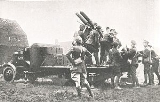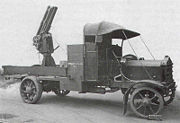
QF 13 pounder 6 cwt AA gun
Encyclopedia
The Ordnance QF 13 pounder Mk III anti-aircraft gun, also known as 13 pounder 6 cwt, was an early British improvisation in World War I
to adapt the 13 pounder field gun
to anti-aircraft use. 6 cwt
referred to the weight of barrel and breech (6 x 112 lb = 672 lb) to differentiate it from other "13 pounder" guns.
 This was a standard QF 13 pounder
This was a standard QF 13 pounder
field gun barrel and breech with the addition of a retaining catch to the breech to retain the round when loading at high angles.
It was first approved in October 1914 and was issued on Mk I high angle mounting, usually mounted on a motor lorry. The Mk I mounting had an additional recuperator housing mounted directly above the normal recuperator to facilitate gun runout at high angles. Hence the appearance was of a gun barrel with 2 slightly shorter tubes of similar diameter above it.
Mk II mount improved the usability, added deflection gear and the recoil system was improved so that the additional recuperator became unnecessary and was removed. On the Mk II mount the gun has the appearance of a standard 13 pounder.
The mount design was unusual in having both gunlayers on the left side.
Following World War I
the guns were returned to service as standard 13 pounder field guns.
and 3 inch 20 cwt
guns took over the major anti-aircraft role.
At the end of World War I
there were only 20 of the guns in service worldwide, with 12 in Egypt and Palestine
, 4 in Mesopotamia
, 2 in Greece (Salonika front
) and 2 on the Western Front
.
World War I
World War I , which was predominantly called the World War or the Great War from its occurrence until 1939, and the First World War or World War I thereafter, was a major war centred in Europe that began on 28 July 1914 and lasted until 11 November 1918...
to adapt the 13 pounder field gun
Ordnance QF 13 pounder
The Ordnance QF 13-pounder quick-firing field gun was the standard equipment of the British Royal Horse Artillery at the outbreak of World War I.-History:...
to anti-aircraft use. 6 cwt
Hundredweight
The hundredweight or centum weight is a unit of mass defined in terms of the pound . The definition used in Britain differs from that used in North America. The two are distinguished by the terms long hundredweight and short hundredweight:* The long hundredweight is defined as 112 lb, which...
referred to the weight of barrel and breech (6 x 112 lb = 672 lb) to differentiate it from other "13 pounder" guns.
History

Ordnance QF 13 pounder
The Ordnance QF 13-pounder quick-firing field gun was the standard equipment of the British Royal Horse Artillery at the outbreak of World War I.-History:...
field gun barrel and breech with the addition of a retaining catch to the breech to retain the round when loading at high angles.
It was first approved in October 1914 and was issued on Mk I high angle mounting, usually mounted on a motor lorry. The Mk I mounting had an additional recuperator housing mounted directly above the normal recuperator to facilitate gun runout at high angles. Hence the appearance was of a gun barrel with 2 slightly shorter tubes of similar diameter above it.
Mk II mount improved the usability, added deflection gear and the recoil system was improved so that the additional recuperator became unnecessary and was removed. On the Mk II mount the gun has the appearance of a standard 13 pounder.
The mount design was unusual in having both gunlayers on the left side.
Following World War I
World War I
World War I , which was predominantly called the World War or the Great War from its occurrence until 1939, and the First World War or World War I thereafter, was a major war centred in Europe that began on 28 July 1914 and lasted until 11 November 1918...
the guns were returned to service as standard 13 pounder field guns.
Combat use
The gun's performance was "ballistically poor" and it was only marginally effective against aircraft. It was relegated to minor war theatres and the 13 pounder 9 cwtQF 13 pounder 9 cwt
The 13 pounder 9 cwt anti-aircraft gun became the standard mobile British anti-aircraft gun of the World War I era, especially in theatres outside Britain...
and 3 inch 20 cwt
QF 3 inch 20 cwt
The QF 3 inch 20 cwt anti-aircraft gun became the standard anti-aircraft gun used in the home defence of the United Kingdom against German airships and bombers and on the Western Front in World War I. It was also common on British warships in World War I and submarines in World War II...
guns took over the major anti-aircraft role.
At the end of World War I
World War I
World War I , which was predominantly called the World War or the Great War from its occurrence until 1939, and the First World War or World War I thereafter, was a major war centred in Europe that began on 28 July 1914 and lasted until 11 November 1918...
there were only 20 of the guns in service worldwide, with 12 in Egypt and Palestine
Sinai and Palestine Campaign
The Sinai and Palestine Campaigns took place in the Middle Eastern Theatre of World War I. A series of battles were fought between British Empire, German Empire and Ottoman Empire forces from 26 January 1915 to 31 October 1918, when the Armistice of Mudros was signed between the Ottoman Empire and...
, 4 in Mesopotamia
Mesopotamian Campaign
The Mesopotamian campaign was a campaign in the Middle Eastern theatre of World War I fought between the Allies represented by the British Empire, mostly troops from the Indian Empire, and the Central Powers, mostly of the Ottoman Empire.- Background :...
, 2 in Greece (Salonika front
Macedonian front (World War I)
The Macedonian Front resulted from an attempt by the Allied Powers to aid Serbia, in the autumn of 1915, against the combined attack of Germany, Austria-Hungary and Bulgaria. The expedition came too late and in insufficient force to prevent the fall of Serbia, and was complicated by the internal...
) and 2 on the Western Front
Western Front (World War I)
Following the outbreak of World War I in 1914, the German Army opened the Western Front by first invading Luxembourg and Belgium, then gaining military control of important industrial regions in France. The tide of the advance was dramatically turned with the Battle of the Marne...
.
Performance
The following table compares the gun's performance with the other British World War I anti-aircraft guns:-| Gun | m/v ft/s | Shell (lb) | Time to 5000 ft (1,524 m) at 25° (seconds) | Time to 10000 ft (3,048 m) at 40° (seconds) | Time to 15000 ft (4,572 m) at 55° (seconds) | Max. height (ft) |
| QF 13 pounder Mk III | 1600 | 12.5 | ? | ? | ? | 17,000 |
| QF 13 pounder 9 cwt QF 13 pounder 9 cwt The 13 pounder 9 cwt anti-aircraft gun became the standard mobile British anti-aircraft gun of the World War I era, especially in theatres outside Britain... |
1990 | 12.5 | 10.1 | 15.5 | 22.1 | 19,000 |
| QF 12 pdr 12 cwt QF 12 pounder 12 cwt AA gun The 12 pounder 12 cwt anti-aircraft gun was borrowed for AA use from the QF 12 pounder 12 cwt coast defence gun with the addition of a modified cradle for higher elevation, a retaining catch for the cartridge, and an additional spring recuperator above the barrel and high-angle sights. Writers... |
2200 | 12.5 | 9.1 | 14.1 | 19.1 | 20,000 |
| QF 3 inch 20 cwt QF 3 inch 20 cwt The QF 3 inch 20 cwt anti-aircraft gun became the standard anti-aircraft gun used in the home defence of the United Kingdom against German airships and bombers and on the Western Front in World War I. It was also common on British warships in World War I and submarines in World War II... 1914 |
2500 | 12.5 | 8.3 | 12.6 | 16.3 | 23,500 |
| QF 3 inch 20 cwt QF 3 inch 20 cwt The QF 3 inch 20 cwt anti-aircraft gun became the standard anti-aircraft gun used in the home defence of the United Kingdom against German airships and bombers and on the Western Front in World War I. It was also common on British warships in World War I and submarines in World War II... 1916 |
2000 | 16 | 9.2 | 13.7 | 18.8 | 22,000 |
| QF 4 inch Mk V WWI QF 4 inch Mk V naval gun The QF 4 inch Mk V gun was a Royal Navy gun of World War I which was adapted on HA mountings to the heavy anti-aircraft role both at sea and on land, and was also used as a coast defence gun.-Naval service:... |
2350 | 31 (3 c.r.h.) | 4.4?? | 9.6 | 12.3 | 28,750 |
| QF 4 inch Mk V WWII QF 4 inch Mk V naval gun The QF 4 inch Mk V gun was a Royal Navy gun of World War I which was adapted on HA mountings to the heavy anti-aircraft role both at sea and on land, and was also used as a coast defence gun.-Naval service:... |
2350 | 31 (4.38/6 c.r.h.) | ? | ? | ? | 31,000 |

